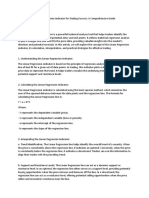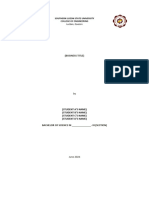Market Structure
Uploaded by
BiantoroKunartoMarket Structure
Uploaded by
BiantoroKunartoMarket structure refers to the overall trend of the market, as well as the smaller
fluctuations within that trend. Smart money traders believe that by understanding
market structure, they can identify the areas where large institutions are likely to
enter or exit the market, and therefore make more informed trading decisions.
There are two main types of market structure: uptrends and downtrends. In an
uptrend, the price of an asset is consistently rising, while in a downtrend, the price is
consistently falling. Within these trends, there are smaller fluctuations, known as
swings. Swings can be either bullish or bearish, and they can last for a few hours,
days, or even weeks.
Smart money traders look for patterns in market structure that can help them predict
where the price is likely to go next. For example, they might look for a break of
structure, which occurs when the price breaks out of a previous swing high or low. A
break of structure can be a sign that the trend is about to change direction.
Another important concept in smart money market structure is liquidity. Liquidity
refers to how easy it is to buy or sell an asset. Assets with high liquidity are easy to
trade, while assets with low liquidity are more difficult to trade. Smart money traders
prefer to trade assets with high liquidity, as this makes it easier to enter and exit
trades without causing large price movements.
By understanding market structure and liquidity, smart money traders can gain an
edge over other market participants. This can help them to make more informed
trading decisions and increase their chances of success.
Here are some of the benefits of understanding market structure in smart money
concepts:
It can help you to identify the overall trend of the market, which can give you
an idea of which direction the price is likely to go in.
It can help you to identify areas where large institutions are likely to enter or
exit the market, which can give you an edge over other market participants.
It can help you to identify patterns in market structure that can help you to
predict where the price is likely to go next.
It can help you to avoid trading in illiquid assets, which can make it difficult to
enter and exit trades.
If you are interested in learning more about market structure in smart money
concepts, there are a number of resources available online. You can also find books
and courses that teach you how to identify and interpret market structure.
You might also like
- (EN) Advance Smart Money Concept-Market Structure95% (20)(EN) Advance Smart Money Concept-Market Structure66 pages
- 4 Keys to Profitable Forex Trend Trading: Unlocking the Profit Potential of Trending Currency PairsFrom Everand4 Keys to Profitable Forex Trend Trading: Unlocking the Profit Potential of Trending Currency Pairs5/5 (13)
- Coating and Drying Defects Troubleshooting Operating Problems, 2nd EditionNo ratings yetCoating and Drying Defects Troubleshooting Operating Problems, 2nd Edition10 pages
- Swing Trading: Simplified - The Fundamentals, Psychology, Trading Tools, Risk Control, Money Management, And Proven Strategies: Stock Market Investing for Beginners Book, #2From EverandSwing Trading: Simplified - The Fundamentals, Psychology, Trading Tools, Risk Control, Money Management, And Proven Strategies: Stock Market Investing for Beginners Book, #23.5/5 (3)
- Smart Money Concepts in The Forex Market: Bikesh Maskey100% (1)Smart Money Concepts in The Forex Market: Bikesh Maskey67 pages
- Smart Money Market Structure Trading Strategy - Dot Net TutorialsNo ratings yetSmart Money Market Structure Trading Strategy - Dot Net Tutorials25 pages
- pdf-en-advance-smart-money-concept-market-structure_compressNo ratings yetpdf-en-advance-smart-money-concept-market-structure_compress66 pages
- Swing Trading: Guide to Investing in Financial Markets, to Create Passive Income, Secrets and Strategies to ProfitFrom EverandSwing Trading: Guide to Investing in Financial Markets, to Create Passive Income, Secrets and Strategies to Profit1/5 (1)
- Stock Market Secrets For Beginners: Get In On This Lucrative OpportunityFrom EverandStock Market Secrets For Beginners: Get In On This Lucrative OpportunityNo ratings yet
- The Complete Guide to Chart Reading: Techniques for Successful Trading Across MarketsFrom EverandThe Complete Guide to Chart Reading: Techniques for Successful Trading Across MarketsNo ratings yet
- The Forex Trader's Blueprint: Navigate the World of Currency MarketsFrom EverandThe Forex Trader's Blueprint: Navigate the World of Currency MarketsNo ratings yet
- Mastering Price Action: Decoding Market Moves for Trading Success: Stock Market, #1From EverandMastering Price Action: Decoding Market Moves for Trading Success: Stock Market, #15/5 (1)
- SWING TRADING: Maximizing Returns and Minimizing Risk through Time-Tested Techniques and Tactics (2023 Guide for Beginners)From EverandSWING TRADING: Maximizing Returns and Minimizing Risk through Time-Tested Techniques and Tactics (2023 Guide for Beginners)No ratings yet
- The Forex and Order Block T - (Z-Library)No ratings yetThe Forex and Order Block T - (Z-Library)17 pages
- Day Trading Strategies: Learn The Key Tools and Techniques You Need to Succeed in Trading Stocks, Forex, Options, Futures, Cryptocurrency, and ETFs Using Insider Technical Analysis and Risk ManagementFrom EverandDay Trading Strategies: Learn The Key Tools and Techniques You Need to Succeed in Trading Stocks, Forex, Options, Futures, Cryptocurrency, and ETFs Using Insider Technical Analysis and Risk Management5/5 (44)
- Swing Trading: A Beginner's Guide to Highly Profitable Swing Trades - Proven Strategies, Trading Tools, Rules, and Money ManagementFrom EverandSwing Trading: A Beginner's Guide to Highly Profitable Swing Trades - Proven Strategies, Trading Tools, Rules, and Money Management3.5/5 (2)
- Swing Trading: A Beginner’s Step by Step Guide to Make Money on the Stock Market With Trend Following StrategiesFrom EverandSwing Trading: A Beginner’s Step by Step Guide to Make Money on the Stock Market With Trend Following Strategies4.5/5 (41)
- Forex Freedom Formula: Turn Currencies Into Consistent Cash FlowFrom EverandForex Freedom Formula: Turn Currencies Into Consistent Cash FlowNo ratings yet
- Swing Trading for Beginners: The Ultimate Trading Guide. Learn Effective Money Management Strategies to Conquer the Market and Become a Successful Swing Trader.From EverandSwing Trading for Beginners: The Ultimate Trading Guide. Learn Effective Money Management Strategies to Conquer the Market and Become a Successful Swing Trader.No ratings yet
- TECHNICAL ANALYSIS FOR BEGINNERS: A Beginner's Guide to Mastering Technical Analysis (2024 Crash Course)From EverandTECHNICAL ANALYSIS FOR BEGINNERS: A Beginner's Guide to Mastering Technical Analysis (2024 Crash Course)No ratings yet
- Day Trading & Options Trading: Trade Like A Pro With Winning Strategies & Precise Technical Analysis to Succeed in Trading Stocks, Commodities, Forex, Futures, Bitcoin and ETFs in Any Market ConditionFrom EverandDay Trading & Options Trading: Trade Like A Pro With Winning Strategies & Precise Technical Analysis to Succeed in Trading Stocks, Commodities, Forex, Futures, Bitcoin and ETFs in Any Market Condition5/5 (26)
- Ultimate Forex Trading Guide: With FX Trading To Passive Income & Financial Freedom Within One Year: (Workbook With Practical Strategies For Trading And Financial Psychology)From EverandUltimate Forex Trading Guide: With FX Trading To Passive Income & Financial Freedom Within One Year: (Workbook With Practical Strategies For Trading And Financial Psychology)No ratings yet
- Forex Trading For Novices Made Simple: Get In On This Lucrative OpportunityFrom EverandForex Trading For Novices Made Simple: Get In On This Lucrative OpportunityNo ratings yet
- When Trends Reverse: The Hidden Dangers of Swing Trading in a Volatile Market EnvironmentFrom EverandWhen Trends Reverse: The Hidden Dangers of Swing Trading in a Volatile Market EnvironmentNo ratings yet
- Cost Efficiency in A Pulper Refers To Optimizing The Performance and Operational Costs Associated With The Pulping ProcessNo ratings yetCost Efficiency in A Pulper Refers To Optimizing The Performance and Operational Costs Associated With The Pulping Process2 pages
- Calculating Steam Cost Involves Considering Several FactorsNo ratings yetCalculating Steam Cost Involves Considering Several Factors2 pages
- Leveraging The Linear Regression Indicator For Trading SuccessNo ratings yetLeveraging The Linear Regression Indicator For Trading Success2 pages
- Trading With The Commodity Channel IndexNo ratings yetTrading With The Commodity Channel Index2 pages
- DCASTFX Advance Pattern Reference Guide RevisedNo ratings yetDCASTFX Advance Pattern Reference Guide Revised2 pages
- Of Love, Blood and The Belly Diana Marcela GómezNo ratings yetOf Love, Blood and The Belly Diana Marcela Gómez528 pages
- Supercontinent Pangaea Proxima in 250 Million Years100% (1)Supercontinent Pangaea Proxima in 250 Million Years3 pages
- An Introduction To Lagrange Multipliers - WWW - SlimyNo ratings yetAn Introduction To Lagrange Multipliers - WWW - Slimy13 pages
- Contextualization A Theory of Gospel and CultureNo ratings yetContextualization A Theory of Gospel and Culture5 pages
- Troemner Scope of Accreditation 2023 24No ratings yetTroemner Scope of Accreditation 2023 2413 pages
- 12 - Glossary - 2016 - Soap Manufacturing TechnologyNo ratings yet12 - Glossary - 2016 - Soap Manufacturing Technology14 pages
- Spectroscopy and Its Application: Chemical and Biological Detection Professor: Nam Sun Wang Haimo LiuNo ratings yetSpectroscopy and Its Application: Chemical and Biological Detection Professor: Nam Sun Wang Haimo Liu19 pages
- Author0fntent - You've Got To Hand It To ReiNo ratings yetAuthor0fntent - You've Got To Hand It To Rei3 pages
- Longitudinal Observation of Anxiety and Depression Among Palliative Care Cancer PatientsNo ratings yetLongitudinal Observation of Anxiety and Depression Among Palliative Care Cancer Patients14 pages
- The Role of Technology On The Development of Traditional CultureNo ratings yetThe Role of Technology On The Development of Traditional Culture2 pages
- City of Naga: Republic of The PhilippinesNo ratings yetCity of Naga: Republic of The Philippines13 pages
- Vedic Heritage List Books On Ayurveda of IGNCA Library PDFNo ratings yetVedic Heritage List Books On Ayurveda of IGNCA Library PDF32 pages
- Kicking in Soccer: Kicking: Art and SportsNo ratings yetKicking in Soccer: Kicking: Art and Sports33 pages
- Tips-And-Tricks-To-Speed-Aws-Deployment PDFNo ratings yetTips-And-Tricks-To-Speed-Aws-Deployment PDF7 pages























































































































